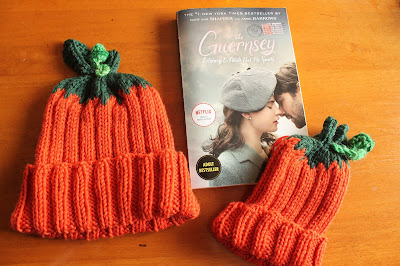Pumpkin Hats and Potato Peel Pie
The knitting is the Punkin' Patch Hat by Glenna Anderson Muse and the novel is The Guernsey Literary and Potato Peel Pie Society by Mary Ann Shaffer and Annie Barrows.
I don't know how many pumpkin hats I've knitted over the years, but I know I've knitted this pattern at least seven times. The Punkin Patch Hat is from the book Warm Hats for Wee Noggins. Each pattern is written for three sizes of a premature baby and three sizes for a full-term baby. I knitted the smaller hat in the newborn size and added some stitches and rows for the older sibling size. It may be a bit larger than it needs to be for its intended recipient, but kids grow.
I love this pattern! There are a lot of wonderfully goofy baby hat patterns out there, and I am up for trying almost any of them. Unlike most pumpkin hat patterns, this one features a leaf AND a tendril. Are these details necessary? No, but neither are pumpkin hats themselves--at least, not strictly speaking. But I, a person who takes an unreal amount of delight in making baby hats, would argue that babies DO need to be dressed up like fruit and animals when they're too small to fight back and if you ARE going to knit a hat that looks like a pumpkin, you may as well fully commit and add those extra goofy details.
A leaf! A tendril! It's so stupid! I've made them for at least half the children I know in the last 5 years and being the friend/aunt who makes ridiculous baby hats is an important part of my identity.
And now, the novel. The Guernsey Literary and Potato Peel Pie Society is set in 1946 and tells the story of a young woman, orphaned at a young age and living in war-torn London, learning of and meeting the resilient residents of Guernsey, a small island occupied by Nazis during the war. But charming! And through letters!
I picked this for my online book club's selection last month. I had seen the Netflix movie last summer, and bought the book at a school book fair for $5 last fall. I read the first few chapters and then let it languish on the shelf. When I was tagged to pick the next month's book, I figured attaching a deadline for finishing the book would motivate me to finish it. I was happy to discover that once I picked the book back up, I was engrossed until the end.
I thought the practice of telling through story solely through characters' letters to one another might wear on me, but it didn't. The characters are engaging, or at least entertaining. The heroine, Juliet Ashton, is winsome but has the levelheadedness and confidence of a woman who has a loving support system and financial security. The characters of Guernsey have each other. Juliet meets them after she receives a letter from a Dawsey Adams, who found her address in a book he bought secondhand. After they strike up a correspondence, she wants to come to the island to meet the members of the "literary society" and write about their group and the effects of the German occupation on their community. She wins everyone's trust by offering up character witnesses--using a former co-worker who dislikes her was hilarious and shrewd--and off she goes, becoming enmeshed in the community faster than the star of a Hallmark movie. I kept checking dates of letters to count the days in surprise at how quickly she was basically raising a little girl she'd met. But that's how charming things go, I guess.
But it's still an interesting read. Juliet is sensitive in learning about the horrors of occupation, and is a thoughtful interviewer when asking her new friends about Elizabeth, a woman everyone mentions but no one knows the status of after she was sentenced to an internment camp. They receive news of her death near the end of the book, and then they decide to take in a woman from the camps that Elizabeth knew. There is so much devastation in this story, good Lord.
There are bits of joy and goodness throughout, though. The literary society kept people in good spirits and offered lonely individuals a chance to connect. The thing that has stuck with me the most was when Dawsey explained to Juliet how the island had no salt (or much of anything else) coming in during the occupation, so people would cook with sea water. He spent a lot of time, bad leg and all, hauling small barrels of sea water to people too old or sick to carry their own. That alone would be enough to make me want to nearly kiss him while wearing an oddly quilted beret like they do on the cover, and it was a striking example of the ways people can take care of one another.






Comments
Post a Comment